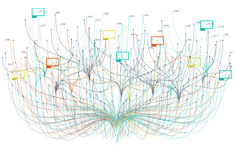How to Master Lidar Data Annotation for Artificial Intelligence Computer Vision Training
Unlocking the Secrets of Lidar Data Annotation for Effective Artificial Intelligence Training
What is Lidar Data Annotation?
Lidar data annotation is the process of labelling or tagging point cloud visual data collected by Lidar sensors. This critical step bridges raw point cloud information with neural networks and machine learning models, enabling artificial intelligence to understand and interpret 3D spatial data.
Why Lidar Data Annotation Matters
Like image annotation for 2D data, Lidar data annotation provides the language that allows AI models to make sense of the 3D world through computer vision and object detection. By detecting objects and defining objects, visual data, boundaries, and spatial relationships, Lidar annotation guides AI in making informed decisions based on complex 3D data.
Lidar data annotation is crucial for several reasons. First, it translates the raw point cloud data from Lidar sensors into meaningful information that AI models can understand and learn from. Just as 2D image annotation helps AI interpret flat images, Lidar annotation enables AI to comprehend objects’ depth, distance, and spatial configuration in a three-dimensional space. This is essential for applications that require high spatial awareness and precision, such as autonomous driving, robotics, and environmental mapping.
In autonomous driving, for example, Lidar data annotation allows AI systems to detect and classify various objects on the road, including vehicles, pedestrians, cyclists, and obstacles. By accurately defining these objects’ boundaries and spatial relationships, annotated Lidar data helps the AI model understand the environment and make real-time decisions, such as navigating through traffic, avoiding collisions, and following traffic rules. This ability to interpret and react to the 3D world is fundamental to the safety and reliability of autonomous vehicles.
Moreover, Lidar annotation enhances object detection by providing detailed information about the shape and size of objects. Unlike 2D images, which can only capture surface details, Lidar data offers a comprehensive view of an object’s geometry. This allows AI models to differentiate between objects with similar visual appearances but different spatial characteristics. For instance, in a warehouse automation scenario, Lidar annotation can help distinguish between similarly sized boxes placed at different heights and distances, enabling robots to pick and place items accurately.
Defining objects and their boundaries in Lidar data also improves the AI model’s understanding of complex scenes. In urban planning and environmental monitoring, annotated Lidar data can analyze terrain, vegetation, and infrastructure. By mapping out the precise locations and dimensions of buildings, trees, and other elements, AI models can assist in flood risk assessment, deforestation monitoring, and urban development planning. The detailed spatial information provided by Lidar annotation is invaluable for making informed decisions in these fields.
Furthermore, Lidar annotation is vital in enhancing the accuracy of spatial relationships within the data. Understanding how objects relate to each other in a 3D space is critical for many applications. In virtual and augmented reality, for example, accurately annotated Lidar data allows for the creation of realistic and immersive environments. By ensuring that virtual objects are correctly positioned and scaled in relation to the real world, AI can create seamless and engaging user experiences.
Lidar data annotation is crucial for AI models to make sense of the 3D world. By providing detailed information about object detection, defining objects, visual data, boundaries, and spatial relationships, Lidar annotation guides AI in making informed decisions based on complex 3D data. This capability is essential for various applications, from autonomous driving and robotics to urban planning and environmental monitoring, making Lidar data annotation a critical component in advancing AI technologies.
Types of Lidar Data Annotations
- Point Cloud Annotation: Labeling individual points within a Lidar-generated point cloud, providing context and understanding of spatial elements.
- Object Detection in 3D: Identifying and image classifying or categorizing objects within a 3D space is crucial for applications like autonomous vehicles and robotics.
- 3D Bounding Boxes: Creating bounding boxes around objects in 3D space, enabling precise localization and object detection or recognition. Think facial recognition…
- Ground Truth Annotation: Establishing the ground truth for Lidar data, ensuring the accuracy of AI or computer vision model predictions.
- Scene Segmentation: Segmenting a Lidar scene into distinct components enhances the model’s understanding of spatial relationships.
- 3D Object Tracking: Tracking the movement of objects in 3D space is vital for computer vision applications like surveillance and monitoring.
Types of Lidar Data Annotation Tools:
Commercial Tools: Industry-grade AI computer science machine vision solutions like Luminar, Velodyne Lidar, and Lidar USA provide advanced Lidar data and processing capabilities for computer vision systems.
Open Source Tools: Platforms like LidarView, Semantic-KITTI, and QGIS offer flexibility and transparency, allowing customization for specific computer vision applications project requirements.
Custom-Built Computer Vision Annotation Tool: Tailoring an annotation tool to the unique demands of Lidar data ensures optimal results and seamless integration with existing workflows.
Lidar data annotation tools are essential for processing and interpreting the complex spatial data generated by Lidar sensors. These tools come in various forms, each offering unique benefits for different needs and applications.
Commercial Tools: Industry-grade AI computer science and machine vision solutions such as Luminar, Velodyne Lidar, and Lidar USA are at the forefront of advanced Lidar data processing. These commercial tools provide robust and reliable performance, catering to high-demand industrial applications. They often come with comprehensive support and regular updates, ensuring users can access the latest features and improvements. For example, Luminar offers high-resolution, long-range Lidar solutions critical for autonomous vehicles, enabling them to detect and react rapidly to their surroundings. Velodyne Lidar provides a range of products tailored for various applications, from automotive to robotics, known for their accuracy and reliability. Lidar USA specializes in mobile mapping systems, offering versatile surveying and geospatial data collection solutions.
Open Source Tools: Platforms like LidarView, Semantic-KITTI, and QGIS provide flexibility and transparency, which are invaluable for researchers and developers who need to customize their tools to meet specific project requirements. LidarView is an open-source tool designed for visualizing and processing Lidar data, allowing users to interact with the data in a detailed and meaningful way. Semantic-KITTI offers a dataset and tools for semantic segmentation of Lidar data, enabling users to develop and test their algorithms on a standardized dataset. QGIS, a widely-used open-source geographic information system, supports Lidar data and offers a range of plugins and tools for spatial data analysis and visualization. These open-source options allow for extensive customization and integration with other tools and workflows, making them ideal for research and development projects that require tailored solutions.
Custom-Built Computer Vision Annotation Tool: Creating a custom-built annotation tool for projects with unique requirements can provide the best results. Tailoring an annotation tool specifically for the demands of Lidar data ensures that it meets the project’s exact needs and integrates seamlessly with existing workflows. Custom tools can be designed to handle specific types of annotations, support particular data formats, and incorporate unique processing algorithms. This approach can optimize the annotation process, enhance accuracy, and improve efficiency. For example, in autonomous driving projects, a custom-built tool can annotate Lidar data with precise labels for road signs, obstacles, and other critical features, enhancing the model’s ability to understand and navigate complex environments.
Various Lidar data annotation tools, including commercial, open-source, and custom-built options, offer diverse solutions to meet different needs. Commercial tools provide advanced capabilities and reliability for industrial applications, open-source tools offer flexibility and customization for research and development, and custom-built tools ensure optimal performance for specific project requirements. By choosing the right type of tool, users can effectively process and annotate Lidar data, enhancing the performance and accuracy of their machine-learning models.
Preparing Data for Lidar Annotation
Before diving into the data science of Lidar annotation, meticulous data preparation of the digital image is essential. A clean, diverse, representative point cloud dataset establishes the foundation for practical annotation.
- Preparing the Point Cloud Dataset: Curate a collection of Lidar scans representing various scenarios and vision environments.
- Specifying Object Classes: Define the categories for annotators to use during Lidar data labelling.
- Assigning Labels: Actively label points in the cloud, bringing 3D spatial information to life.
- Marking Objects: Create 3D bounding boxes, specifying the boundaries of objects of vision interest.
- Exporting Annotations: Transform annotated Lidar data science into a format suitable for training vision datasets.
- Post-Processing for Accuracy: Correct discrepancies by ensuring labelled image data aligns with the ground truth.
- Iterative Feedback: Inconsistencies prompt additional Lidar data labeling rounds, ensuring accuracy.
Common Challenges and Solutions
Embarking on Lidar data annotation comes with challenges, but these hurdles are opportunities for growth and innovation.
Striking the Balance Between Costs and Accuracy
- The Dilemma: In vision data annotation, there is a perpetual tug-of-war between the need for image processing accuracy, the latest computer vision technology, and budget constraints.
- Human vs. Automated Annotation: Human vision annotation is meticulous but time-consuming, while automated AI vision, i.e. annotation, though cost-effective, raises questions about visual data result precision.
- The Solution: Balance involves understanding project requirements and strategically leveraging the strengths of both human and automated annotation.
Ensuring Consistency in Lidar Data
- The Importance of Consistency: Consistent Lidar computer vision data and algorithms are essential for effective machine learning models.
- Human Interpretation Challenges: Variability in annotator interpretations, visual information, pattern recognition, and image processing can introduce inconsistencies in the point cloud dataset.
- The Solution: Rigorous training for annotators and clear guidelines maintain high consistency in object recognition, visual inspection and labelled Lidar data.
Choosing the Right Lidar Annotation Tool
- The Paradox of Choice: The market offers various computer vision or Lidar annotation tools, each with unique features, making selection and image processing challenging.
- Matching Tools with Skillsets: A tool may be feature-rich and loaded with excellent feature extraction, but if it doesn’t align with your team’s skills, challenges may arise.
- The Solution: Thoroughly analyze project requirements, necessary data analytics team capabilities, and tool learning curves. Opt for platforms that align with technical demands and ensure user-friendly interfaces.
Ethical Considerations in Lidar Data Annotation
- Guarding Against Algorithm Biases: Computer Vision or Lidar Annotators may introduce biases based on cultural backgrounds or beliefs through the visual input they receive.
- Mitigating Ethical Concerns: Implement robust guidelines, diversity training, and vigilant monitoring to detect and rectify biases.
- The Solution: Foster an ethical artificial intelligence environment through education, diversity initiatives, and continuous monitoring of the annotation process.
Continuous Learning in Lidar Annotation
- The Ever-Evolving Nature of AI: Machine learning models evolve, requiring annotators to adapt to changing vision model and image recognition needs.
- Adaptability and Training: Regular training sessions and up-skilling are vital for annotators.
- The Solution: Embrace a culture of continuous learning with ongoing computer vision training, feedback loops, and keeping up with computer vision news on various topics, such as augmented reality, deep learning, and knowledge sharing.
Teaching Your AI Model New Tricks
If you’re a new or budding data scientist, the training process is an evolving AI and generative AI journey. As new Lidar data and computer vision tools or connection points offering real-time data processing through computer vision systems like edge AI are introduced, the model can learn an additional algorithm or one thousand patterns, refining its ability to make nuanced predictions.
Teaching your AI model new tricks involves continuously updating and refining the model to improve its performance and adapt to new data and technologies. This dynamic process is essential for keeping the AI model relevant and effective. For a budding data scientist, understanding this evolution is crucial for mastering the art of machine learning.
Incorporating new data sources, such as Lidar data, is one way to enhance the model’s capabilities. Lidar, or Light Detection and Ranging, provides high-resolution spatial data that can significantly improve the accuracy of models used in applications like autonomous vehicles and geographic information systems. Integrating this data allows the model to make more precise spatial predictions and better understand three-dimensional environments.
As mentioned earlier, the advent of advanced computer vision tools plays a pivotal role in teaching AI models new tricks. Computer vision systems can process and analyze visual data, enabling models to recognize objects, detect anomalies, and interpret scenes. These tools and real-time data processing capabilities allow AI models to respond to dynamic environments quickly and accurately. For instance, in industrial automation, real-time computer vision can help monitor production lines, detect defects, and optimize processes.
Edge AI further enhances the training process by bringing computation and data storage closer to the location where it is needed. This reduces latency and allows for real-time data processing, making the AI model more responsive. Edge AI is particularly valuable in applications requiring immediate decision-making, such as in healthcare for patient monitoring or in smart cities for traffic management.
As new algorithms are developed, they can be incorporated into the model to improve performance. The algorithm might include advanced machine learning techniques, such as reinforcement learning, which enables the model to learn from its interactions with the environment. By learning multiple algorithms, the model can develop a more sophisticated understanding of patterns and make more nuanced predictions.
Learning and integrating a new algorithm is essential for generative AI. Generative AI models, such as those used in natural language processing or image generation, benefit from continuous learning to produce more accurate and creative outputs. By refining these models with new data and algorithms, a data scientist can enhance their generative capabilities, enabling applications like automated content creation, artistic design, and personalized user experiences.
Teaching your AI model new tricks is a continuous and evolving process. By incorporating new data sources like Lidar, utilizing advanced computer vision tools, leveraging edge AI for real-time processing, and integrating a new algorithm, a data scientist can significantly enhance the capabilities of their AI models. This journey improves the model’s performance and prepares it to tackle increasingly complex and nuanced tasks.
Need help with Lidar Data Annotations?
If you’re interested in keeping up to date with all the computer vision news, need help with your organization’s computer vision needs, or need Lidar data annotation, discover more about our Lidar Data Annotation services for expert assistance.
Happy reading!










